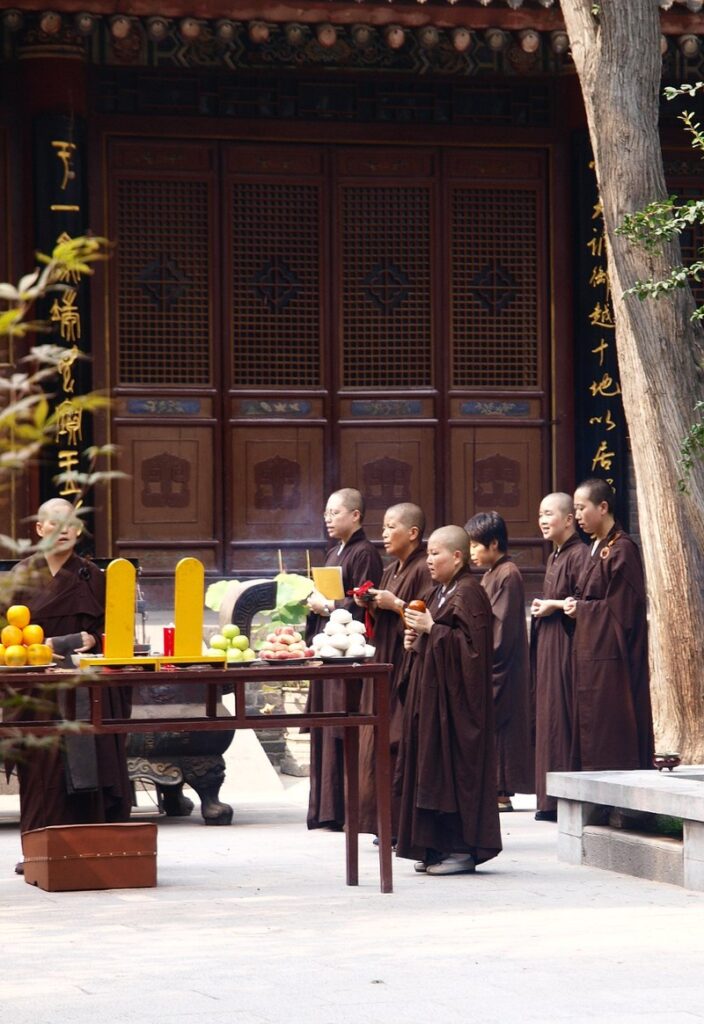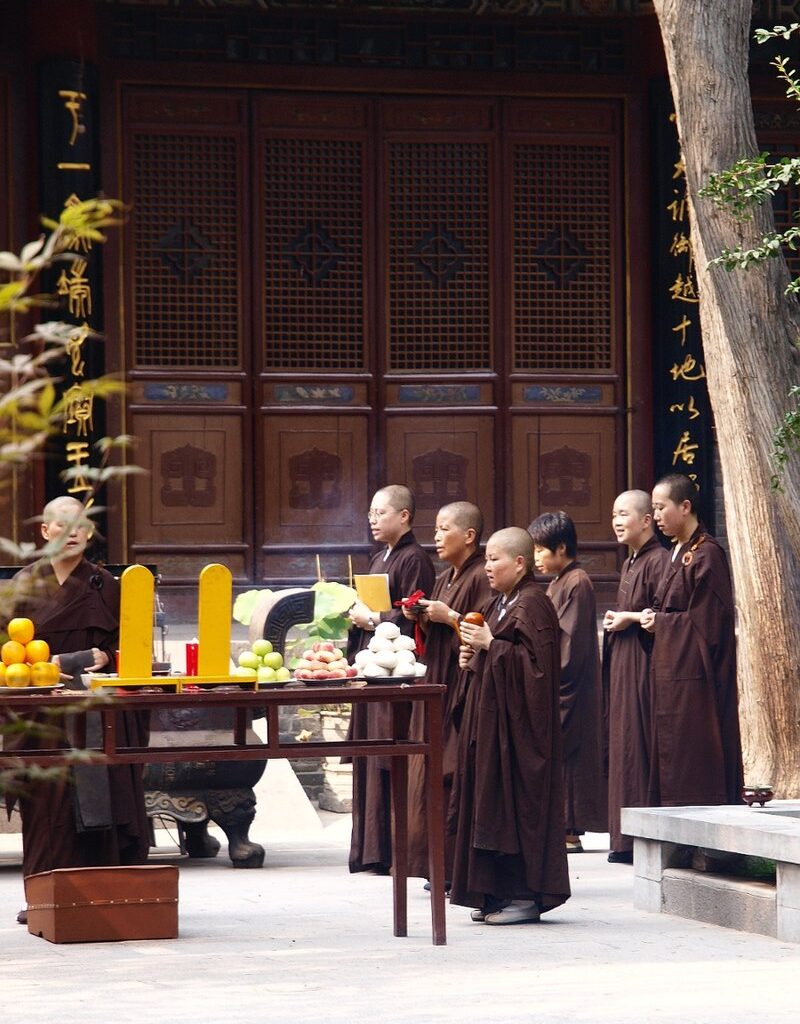
Burmese Theravada (political Buddhism) considers the bhikkhuni order of fully ordained nuns to be extinct and has declared that no bhikkhuni ordination may take place now. The present nuns of Burma are not regarded as full female equivalents of the bhikkhunis. Instead, they are referred to as novice nuns (a thilashin). Unlike the original order’s bhikkhunis, who took 311 precepts, or the monks, who still take 227 precepts, Burmese nuns can only take ten precepts.
Theravada Buddhism and bhikkhuni
Bhikkhuni is the feminine form of bhikkhu, i.e. a fully ordained male, with the same rank as a bhikkhu. In Buddhism, bhikkhunis have the same livelihood and almost all the same privileges and responsibilities as bhikkhus. The Bhikkhuni Sangha has existed since the Buddha’s time and is still active in China, Korea, and Vietnam. Elsewhere in Theravada Buddhism, we are witnessing the start of a resurrection of this historical women’s monastic tradition. In Burma, however, things are more complicated, owing to the patriarchal culture of Burmese Theravada Buddhism.
The current order of Burmese nuns enjoyed a great period of prosperity under the religious reforms promoted by King Mindon, who built Mandalay and hosted the Fifth Buddhist Council there in the nineteenth century. Saya Kin and May Nat Pe, two orphans of war from Manipur (now India) who arrived in Burma as children and were adopted by a royal minister, were the most notable nuns of the period. It is still a mystery why King Mindon did not go all the way and choose to resurrect the bhikkhuni lineage.
Burmese Buddhism in the light of feminism
Though, for example, there are no legitimate laws stopping women from taking part in the workplace in Burma, patriarchal values deeply rooted in religion, culture, the colonial legacy, and capitalism still serve to prevent women from achieving full equality. Here, it is important to note that the Western decolonial academic approach of viewing colonialism as being the sole root of oppressive values such as patriarchy, sexism, homophobia, and transphobia is superficial.
Aung San Suu Kyi, currently the State Counsellor, is considered a symbol of women’s liberation by the general population. However, Aung San Suu Kyi herself and the so-called liberal feminists who support her fail to speak out against the patriarchal norms to be found in Burma’s religious society and culture. Similarly, most mainstream feminists focus on corporate feminism and ignore the rights of working-class women. Contemporary feminists advocate for the use of make-up and champion Westernised beauty standards and corporate gender quotas. On the other hand, Western-trained, so-called decolonialist academics are too busy importing Eurocentric anti-white decolonial feminist standards instead of advocating for a grassroots and indigenous feminism that challenges the patriarchy, which is deeply rooted in religion, culture, colonialism, and capitalism.
However, there have been a few organic intellectuals who dared to question the deeply embedded patriarchal values within Burma’s religious traditions.
Venerable Ardissa Wuntha, a Burmese revolutionary monk from the previous century known for his radical social reforms within Theravada Buddhism, is one of the pioneer Buddhist reformers who talked about indigenous feminism in colonial Burma. In the 1930s, he advocated reviving the bhikkhuni practices that had been extinct in Burma for nearly 1,000 years.
Because of his influence on progressive Buddhists of his generation, the debate reached a national level. The fundamentalists and conservatives, including monks and nationalist politicians, more numerous than the progressives, decided to boycott his books and teachings and denied his right to express his opinions. The Buddhist fundamentalists brutally attacked his dharma-sharing events. His books were burned and those who publicly supported his progressive ideas were singled out and cancelled. However, all these things did not stop him from writing more books or advocating for change. Nevertheless, due to the immense pressure of the cancel culture he faced, he was forced to disrobe when he reached his sixties, while several other attempts to reintroduce the bhikkhunis to Burma also failed.
Criminalising the first bhikkhunis in contemporary Burma
A few decades after Venerable Ardissa Wuntha was targeted for championing a progressive and inclusive Buddhism, two Burmese nuns who were studying abroad decided to become bhikkhunis in Sri Lanka.
One of them was Venerable Saccavadi, who became a thilashin at 21 and received top grades in state-sponsored Buddhist tests following her ordination. In 1998, after being a thilashin for 16 years, she decided to study for a degree in Buddhist literature at a Sri Lankan university. There, she saw a sight she had never seen in Burma: nuns dressed in the same saffron robes as fully ordained monks.
This motivated her to follow in their footsteps. However, when she sought assistance from Burmese monks in Sri Lanka, she was told that bhikkhuni ordination was not allowed for women. These monks then complained about her to the State Sangha Maha Nayaka Committee (SSMNC), a government-backed council of senior Burmese monks. Despite the SSMNC’s objections, Saccavadi and another Burmese thilashin named Gunasari continued on their path and became ordained as bhikkhunis in 2003—the first female Burmese novices to attain bhikkhuni status in contemporary times.
Saccavadi returned to Burma two years later when her father fell ill. Upon learning of this, the SSMNC launched an official investigation regarding her bhikkhuni ordination. As a result, Saccavadi was charged with ‘impersonating a monk’ and summoned to justify herself to the SSMNC’s top monks shortly after her father died. The monks demanded that she bow to them three times, exchange her saffron bhikkhuni garments for the clothing of a thilashin, and sign and read aloud a statement renouncing her ordination.
She obliged almost all of these demands but felt unable to read the statement aloud. Addressing the laypeople instead, she said, ‘Please forgive me if I have abused your support. I have accepted your alms food not as a beggar but as a female monastic who has tried to follow the teachings of the Buddha.’ Still refusing to meet the monks’ demands, she was eventually sentenced to five years in prison.
Saccavadi ended up in Insein prison, infamous for its harsh treatment of inmates, many of whom are political dissidents or political prisoners of conscience. The words of one inmate suffice to illustrate what Saccavadi and countless others went through in Insein: ‘There’s only one word for what life was like inside Insein prison—hell.’ After her release from prison, Saccavadi was forced to leave Burma and, despite activism in both the 20th and 21st centuries, becoming a lower-ranked thilashin is still the only option within Burma for women who want to enter the monastic life.
Conclusion: the need for global feminist solidarity
Saccavadi’s story demonstrates just how patriarchal and oppressive Burmese Theravada Buddhism currently is. Gender apartheid in Burma exists because of political Buddhism and a lack of secularism. Buddhism has long been an oppressive, state-backed force in Burma. What Burma needs urgently is a secular and democratic constitution.
During the Spring Revolution following the 2021 military coup, progressive values were adopted by much of the population. Many Western-trained academics used the opportunity to inject Eurocentric feminism, identity politics, and so-called anti-imperialism into the discourse. Their ignorance of the local context meant, however, that they entirely forgot to spotlight the century-long, spontaneous, and organic struggle for bhikkhuni ordination in Burma. Though the colonial heritage, imperialism, and capitalism undoubtedly maintained or exacerbated oppressive practices rooted in conservative values, it is essential to recognise that the reactionary and patriarchal aspects of Burmese Theravada (political Buddhism) have organic origins in religious scriptures and indigenous culture and norms.
The movement for bhikkhuni ordination is a local spontaneous revolutionary feminism that needs solidarity from the global feminist movements. Even in the religious context, bhikkhuni ordination was accepted and appreciated by Buddha during his time. Theologically and historically, it is legitimate for Buddhist women to attempt to become bhikkhunis. With the solidarity of global feminist movements, the rights of Burmese Buddhist women might finally be realised. A secular Burma would be one in which Buddhist women are not relegated as second-class novice nuns, segregated from their male peers, and essentially seen as the servants of male clerics.
The right of women to be equal to male monks will boost the feminist struggle in Burma and put a knife through the heart of political Buddhism and its conservative, misogynist monk class. The clergy class, instead of being filled with ultranationalists and conservatives, will become a place where different ideas flourish. This will help to transform the whole of Burmese society into a more open-minded one. As such, the struggle for equality and democracy in Burma is incomplete without the struggle for full female ordination.
Related reading
Buddhism: The Religion That Wasn’t—And Now Is (Part One), by Brian Victoria
Awry in the Orient: some problems with Eastern philosophies, by Nicholas E. Meyer
The rise and fall of god(s) in Indian politics: Modi’s setback, Indic philosophy, and the freethought paradox, by Kunwar Khuldune Shahid
Religion and the decline of freethought in South Asia, by Kunwar Khuldune Shahid
Can sentientism save the world? Interview with Jamie Woodhouse, by Emma Park
Feminism and religion are incompatible, by Maryam Namazie
Defending liberalism: interview with Helen Pluckrose, by Daniel James Sharp
My journey from blindness to rationality: how English literature saved me, by Sonia Nigar
From the streets to social change: examining the evolution of Pakistan’s Aurat March, by Tehreem Azeem
South Asia’s silenced feminists, by Kunwar Khuldune Shahid
The ‘Women’s Revolution’: from two activists in Iran, by Rastine Mortad Sadaf Sepiddasht
The Taliban’s unceasing war on Afghan women, by Khadija Khan
The hijab is the wrong symbol to represent women, by Khadija Khan
Golani’s Syria: Post-Assad nation-building hinges on resisting Islamisation, by Kunwar Khuldune Shahid
A Small Light: Acts of Resistance in Afghanistan, by Zwan Mahmod
Coerced faith: the battle against forced conversions in Pakistan’s Dalit community, by Shaukat Korai
‘We need to move from identity politics to a politics of solidarity’ – interview with Pragna Patel, by Emma Park
Reproductive freedom is religious freedom, by Andrew Seidel and Rachel Laser
‘The best way to combat bad speech is with good speech’ – interview with Maryam Namazie, by Emma Park









1 comment
I salute the author for bringing this very important issue to the readers of the FreeThinker. In Buddhist societies in Asia, Buddhism, like religions everywhere, has often been associated with social oppression, of which patriarchy is one major expression. And, as the author states, Buddhist-supported patriarchy was prevalent long before the advent of Western colonialism (though Western colonialists were all too happy to support it). Further, the author is quite correct when he writes, “Buddhism has long been an oppressive, state-backed force in Burma.” I would, however, point out this is not only true of Buddhism in Burma but, historically speaking, of Buddhism throughout the countries of Asia just as it is in all other religions. The state will always gladly co-opt and use religion for its own purposes, typically with the support of the clergy who themselves benefit from this collaboration. That said, there is more to the universal prevalence of patriarchy than religious support alone, for the shift from hunter-gatherer societies to agrarian societies is closely related to the rise of patriarchy. This shift brought changes in labor division, property ownership, and the consolidation of male power. Nevertheless, to its shame, today’s religions, Buddhism included, have always been all to willing to support this shift in their own self-interest and in disregard of their own teachings on the fundamental equality of all adherents. Please keep up the good work!
P.S. Note, however, the real problem is not “political Buddhism,” for the historical Buddha was quite willing to give political as well as spiritual advice to all and did not distinguish between the two. The real problem is when Buddhist leaders support the oppressive social structures of their societies for their own benefit, sacrificing the wellbeing of their believers on behalf of their rulers. Once again, this is a universal problem in all religions to one degree or another (albeit, thankfully, there are some wonderful exceptions!)
Your email address will not be published. Comments are subject to our Community Guidelines. Required fields are marked *
Donate